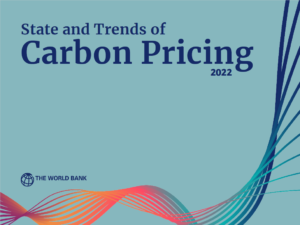Blog: World Bank 2022 Carbon Pricing Report LaunchGlobal carbon pricing generating record revenues but much potential remains untapped

24 May 2022 | The climate crisis continues to escalate amid a prolonged pandemic, increasing economic instability and geopolitical tensions. The latest work from the Intergovernmental Panel on Climate Change makes plain that we must arrest rising emissions now to ward off climate danger. Meeting this challenge in uncertain times calls for ambitious, just, and comprehensive action by policymakers. In this regard, carbon pricing, within an integrated policy mix, is one of the most powerful tools for guiding economies toward low emissions paths. To maximize the benefits, carbon price signals must be sustained, strengthened, and extended to a greater portion of global emissions, three-quarters of which are currently untouched by carbon pricing instruments. However, recent economic instability, volatile energy markets and rising energy prices exacerbate the political challenges for policymakers.
The World Bank’s annual report on the State and Trends of Carbon Pricing continues to provide a trusted global snapshot of carbon pricing developments year to year. The past year has seen some positive signs, particularly in relation to higher carbon prices, increased revenues, progress towards resolving cross-border issues, and the adoption of new rules for international carbon markets (under Article 6 of the Paris Agreement). However, as with previous years, progress has been far from adequate. As of April 1, 2022, only four new carbon pricing instruments had been implemented in the past year and despite record-high prices in some jurisdictions, the price in most jurisdictions remains well below the levels required to deliver on the Paris Agreement temperature goals.
Such an impressive increase highlights carbon pricing’s burgeoning potential to reshape incentives and investment toward deep decarbonization. Further, it illustrates carbon pricing’s potential role as a broader fiscal tool to contribute towards broader policy objectives, such as to restore depleted public finances, aid pandemic recovery, or support vulnerable sectors and communities to adapt to climate impacts and achieve just transitions.
“In 2021, higher carbon prices, revenue from new instruments, and increased auctioning in emissions trading systems have resulted in a record USD 84 billion of global carbon pricing revenue, around 60% higher than in 2020.”
The European Union moved closer to adopting its Carbon Border Adjustment Mechanism, while Canada and other jurisdictions reaffirmed their commitments to investigate border carbon adjustments and bring down hitherto daunting technical and political barriers to such reforms. The COP26 agreements on new rules for international carbon markets help pave the way for more cross-country collaborations and trade.
Encouragingly, more countries continue to explore options to introduce a carbon price, including in low- and middle-income countries. This includes developing advisory services, analytics, innovation and hosting initiatives such as the Partnership for Market Implementation (PMI). The PMI will provide technical assistance to at least 30 countries in developing and implementing domestic carbon pricing and operationalizing Article 6 of the Paris Agreement.
The World Bank Group’s Climate Change Action Plan (2021-25) committed to increase the World Bank’s climate finance target, align financing flows with the goals of the Paris Agreement, and achieve results that integrate climate and development. Through this Action Plan, the World Bank Group is well positioned to leverage its convening power, knowledge and research, and country program support to help countries make informed climate decisions, including on carbon pricing.
This piece appears as a World Bank Blog and the foreword of the 2022 annual State and Trends of Carbon Pricing report. The full report is available for download here.
Please see our Reprint Guidelines for details on republishing our articles.

